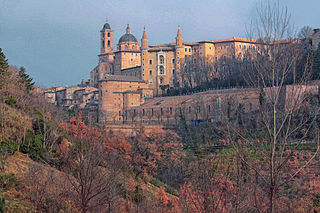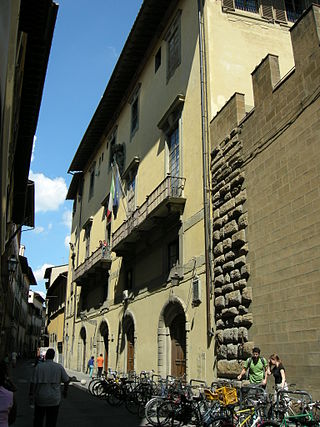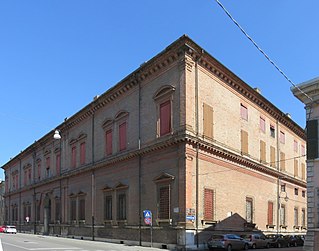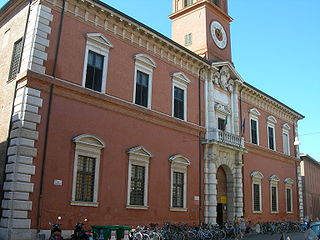
Urbino is a walled city in the Marche region of Italy, south-west of Pesaro, a World Heritage Site notable for a remarkable historical legacy of independent Renaissance culture, especially under the patronage of Federico da Montefeltro, duke of Urbino from 1444 to 1482. The town, nestled on a high sloping hillside, retains much of its picturesque medieval aspect. It hosts the University of Urbino, founded in 1506, and is the seat of the Archbishop of Urbino. Its best-known architectural piece is the Palazzo Ducale, rebuilt by Luciano Laurana.

Rovereto is a city and comune in Trentino in northern Italy, located in the Vallagarina valley of the Adige River.

Palazzo Braschi is a large Neoclassical palace in Rome, Italy and is located between the Piazza Navona, the Campo de' Fiori, the Corso Vittorio Emanuele II and the Piazza di Pasquino. It presently houses the Museo di Roma, the "Museum of Rome", covering the history of the city in the period from the Middle Ages through the nineteenth century.

Palazzo dei Diamanti is a Renaissance palace located on Corso Ercole I d'Este 21 in Ferrara, region of Emilia Romagna, Italy. The main floor of the Palace houses the Pinacoteca Nazionale di Ferrara.

The Palazzo Colonna is a palatial block of buildings in central Rome, Italy, at the base of the Quirinal Hill, and adjacent to the church of Santi Apostoli. It is built in part over the ruins of an old Roman serapeum, and it has belonged to the prominent Colonna family for over twenty generations.

The Palazzo Buonaccorsi is an 18th-century aristocratic palace, now the civic museum of the town, located on Via Don Minzoni 24 in the historic center of Macerata, region of Marche, Italy.

The Chigi Palace is a palace and former noble residence in Rome which is the seat of the Council of Ministers and the official residence of the Prime Minister of Italy. Since 22 October 2022, the tenant of the Chigi Palace has been Prime Minister Giorgia Meloni. It is located in the Piazza Colonna, next to Palazzo Montecitorio, seat of the Chamber of Deputies.

The Biblioteca Riccardiana is an Italian public library under the aegis of the Ministry of Culture, located inside the Palazzo Medici Riccardi at 10 Via de’ Ginori in Florence, in the neighborhood comprising the Mercato Centrale and the Basilica di San Lorenzo. Its main feature is preserving books collected by members of the Riccardi family and making them available in the very same rooms that were originally dedicated to that purpose. So, still today the library boasts the magnificent bookshelves, neatly carved and gilded, that create the atmosphere of a late-seventeenth-century patrician library, whose main features have all been kept intact.
The Biblioteca Comunale Ariostea is located in the Palazzo Paradiso in central Ferrara, region of Emilia-Romagna, Italy. It was named Ariostea, because the collection contains manuscripts related to the author, and within the palace also lies the tomb of Ludovico Ariosto.
Paolo Canevari is an Italian contemporary artist. He lives and works in New York City. Canevari presents highly recognizable, commonplace symbols in order to comment on such concept as religion, the urban myths of happiness or the major principles behind creation and destruction.

The Zone 1 of Milan, since 2016 officially Municipality 1 of Milan, is one of the 9 administrative divisions of Milan, Italy.

The Museum of Modern and Contemporary Art of Trento and Rovereto (MART) (Museo d'Arte Moderna e Contemporanea di Trento e Rovereto, in Italian) is a museum centre in the Italian province of Trento. The main site is in Rovereto, and contains mostly modern and contemporary artworks, including works from renowned Giorgio Morandi, Giorgio de Chirico, Antonio Rotta, Felice Casorati, Carlo Carrà, and Fortunato Depero. Fortunato Depero's house in Rovereto (known as Casa d'Arte Futurista Depero) is also part of the Museum.

The Palazzo D'Afflitto is a palace located in the San Giuseppe neighbourhood of Naples, Italy, adjacent to the Palazzo Capomazza di Campolattaro. It used to belong to the princely family d'Afflitto. In the third floor is the recently restored Church of the Real Monte Manso di Scala, built atop the famed Cappella Sansevero. The palace was built in the 15th century but underwent numerous reconstructions.

The Palazzo Massari, also known as the Palazzo Rosso, is a Renaissance-style palace located on Borso and Corso Porta Mare, at the northwest corner of Piazza Ariostea, in Ferrara, region of Emilia-Romagna, Italy.

The Palazzo Paradiso is a Renaissance palace located on Via Scienze #17 in the medieval center of Ferrara, region of Emilia-Romagna, Italy. Adjacent to the historic Jewish ghetto of Ferrara, it houses:

The Modern Art Gallery of Palermo is a civic art gallery of Palermo, displaying works from the 19th until the early 20th century, located on Via Sant'Anna #21, adjacent to the church of Sant'Anna la Misericordia in the ancient quarter of the Kalsa of the city of Palermo, region of Sicily, Italy. The collections were moved to this site, consisting of the former Franciscan convent associated with Sant'Anna and the adjacent Palazzo Bonet.
Gabriella Belli is an Italian art historian and curator, currently director of the Foundation for the municipal museums of Venice .

The Biblioteca Civica Romolo Spezioli or Biblioteca Civica di Fermo is a public library located on the Piazza del Popolo in the town center of Fermo, region of Marche, Italy.

Bianca Laura Saibante (1723–1797) was an 18th-century Italian poet and playwright. Born into a wealthy family, she is considered one of the founders of the Accademia Roveretana degli Agiati in Rovereto.
Lea Vergine, born Lea Buoncristiano, was an Italian art critic, essayist and curator.

















